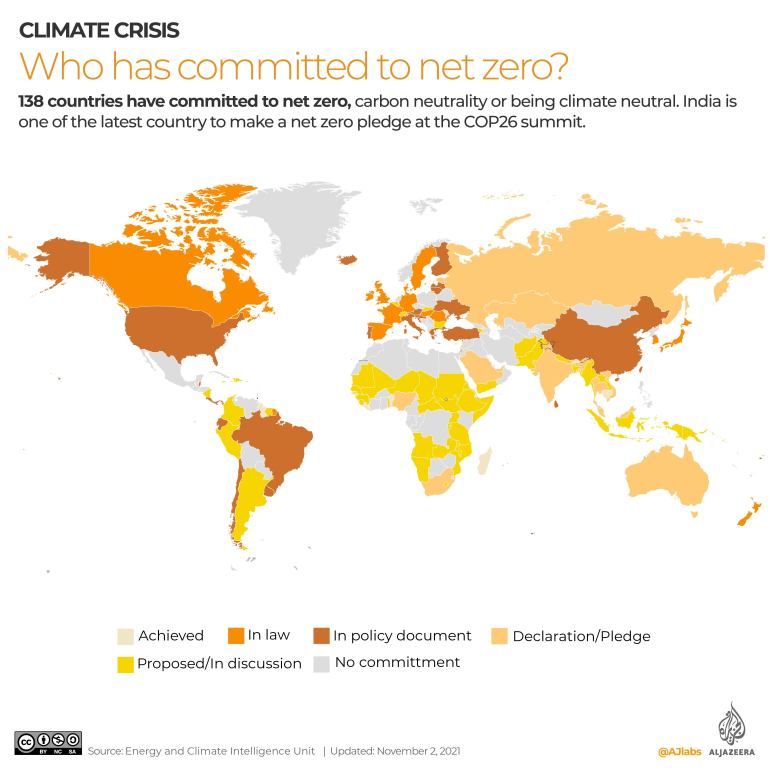Concern grows over Atlantic Ocean ‘conveyor belt’ shutdown
Effects of climate change are slowing a key ocean circulation system with immense consequences for Earth’s climate if it collapses.

For thousands of years, the circulating currents of the Atlantic Ocean have continuously regulated the temperatures of Europe and North America, producing a warming effect that allows them to enjoy relatively moderate weather conditions.
But the effects of anthropogenic climate change have diminished the flow of this vast conveyor belt system, known as the Atlantic Meridional Overturning Circulation (AMOC), and recent scientific research suggests it may even be headed for collapse.
Keep reading
list of 4 itemsChina-US declaration on climate only first step, analysts say
The climate crisis is about the Global South’s present
UN climate negotiations enter final day as differences remain
The unprecedented slowdown of the vast system has been measured directly since 2004, but analysis of indirect data suggests a longer decline, beginning in the mid to late 19th century and accelerating after 1950.
One study, which looked at ice cores and ocean sediments, determined the AMOC was “in its weakest state in over a millennium”.
“Everything points to a weakening of the AMOC,” said Sybren Drijfhout, an oceanographer at the University of Southampton.
The timeline of a potential collapse of the AMOC remains unclear, but the consequences for the Earth’s climate would be immense.
Temperatures in Europe and the east of North America would drop by as much as 5 degrees Celsius (9 degrees Fahrenheit), leading to more extreme winter weather.
Coastal cities in North America would be flooded by rising sea levels. It would also disrupt the West African and Asian monsoons, which supply vital rainfall for crops that tens of millions of people depend upon.
How AMOC works
An enormous system of ocean currents, the AMOC is driven by changing water density, which is determined by the water’s salt content and temperature.
Under a process known as “thermohaline circulation”, warm water moves north through the Gulf of Mexico towards Europe – the stretch known as the Gulf Stream – with the surface temperature decreasing as evaporation occurs and salinity increases.
Becoming denser, the water then sinks in the north Atlantic and whisks south along the ocean floor before “upwelling” to the surface again far into the southern hemisphere.
The effects of global warming on the AMOC are twofold. Warmer water is less dense, and freshwater runoff from ice melting in the polar region reduces salinity, which reduces density even further. These factors slow the sinking mechanism that propels the circulation.
The last time the AMOC shut down was towards the end of the last ice age, about 14,500 years ago. Then glacial melt flooded the North Atlantic with fresh water, collapsing the system and causing temperatures in Europe to plunge.
The Intergovernmental Panel on Climate Change (IPCC) report published in August found with high confidence that the AMOC will likely weaken over the coming decades, but a total collapse before 2100 is unlikely.
“Even though the AMOC is very unlikely to collapse over the 21st century, its weakening may be substantial, which may therefore induce strong and large-scale climatic impacts with potential far-reaching impacts on natural and human systems,” it said.
‘Very massive impact’
Whether the decline of the AMOC will continue in a linear fashion, or reach some tipping point, after which the decline could accelerate precipitously, remains a point of discussion among scientists.
“That’s the million-dollar question,” said Niklas Boers, a researcher at the Potsdam Institute for Climate Impact Research. “Whether it’s just linear, slowing down, or whether there’s actually a loss of stability.”
A paper published by Boers in the Nature Climate Change journal in August analysed eight separate indicators, making use of sea surface temperature and water salinity data that stretches back to the 19th century.
It found the AMOC may have evolved from a period of relative stability towards a “critical” transition that would signal a profound change in the global climate system. Such a tipping point could see the AMOC halt entirely over a relatively short period of decades.
“We have a situation where there’s a threshold … If we reached that threshold, then we will have a very, very massive impact that is possibly practically irreversible,” said Boers.
‘Reduce emissions as fast as possible’
Discrepancies between observed data and existing climate models remain, and there is still no consensus on how long a full shutdown could take. Some estimates suggest as long as several hundred years.
“All models agree that in warmer climates that the AMOC will become weaker and weaker,” said Drijfhout. “That doesn’t have to mean a collapse. It could go very, very gradually.”
In either case, Western Africa will have to adapt to declining rainfall and Europe to increasingly unpredictable winter weather, on top of other effects already produced by climate change.
Further advances in climate modelling could provide a more accurate picture of things to come, but the evidence is already clear that reducing human-caused global heating will be crucial to maintaining stability in the Atlantic system.
The most important factor in how the AMOC develops is the amount of greenhouse gases that will be released into the atmosphere in the coming years and decades, said Boer.
“There’s not so much room for compromises. So you have to really reduce emissions as much as possible – and as fast as possible.”